
Welcome to the Money Bag, where I answer questions and address comments from readers on a wide range of money topics, myths, and perceptions about money. No question is off limits, so hit me up in the comments section or send me an email about any money topic that’s on your mind.
This edition of the Money Bag answers your questions about cryptocurrency FOMO, selling stocks at a loss, selling stocks at a gain, and comparing your finances to others.
First up is Terri, who wants to know if she should invest a small amount of money in cryptocurrency, given its recent ‘hype’. Take it away, Terri:
Cryptocurrency FOMO
Hi Robb,
I wanted to get your opinion on this crazy cryptocurrency move – I’m sure you’re getting a lot of questions about it. I’m not sold on it as an alternative to fiat currencies or a way to hedge against inflation. To be honest I’m not 100% sure how it works and I don’t think anyone really understands how it derives value. However, it does seem like an opportunity to invest in an asset class in its infancy. Have you done much research into this? I will admit to having some “FOMO” with the recent move, I think I’d like to look into investing a very small portion.
Hi Terri,
I’ll be honest, I heard more about Bitcoin during its last run-up at the end of 2017. That culminated when our 19-year-old restaurant server talked about wanting to buy it with her student loan money. The price proceeded to plummet from nearly $20,000 per coin to about $8,000 in two months and continued down to as low as $3,200 per coin a year later.
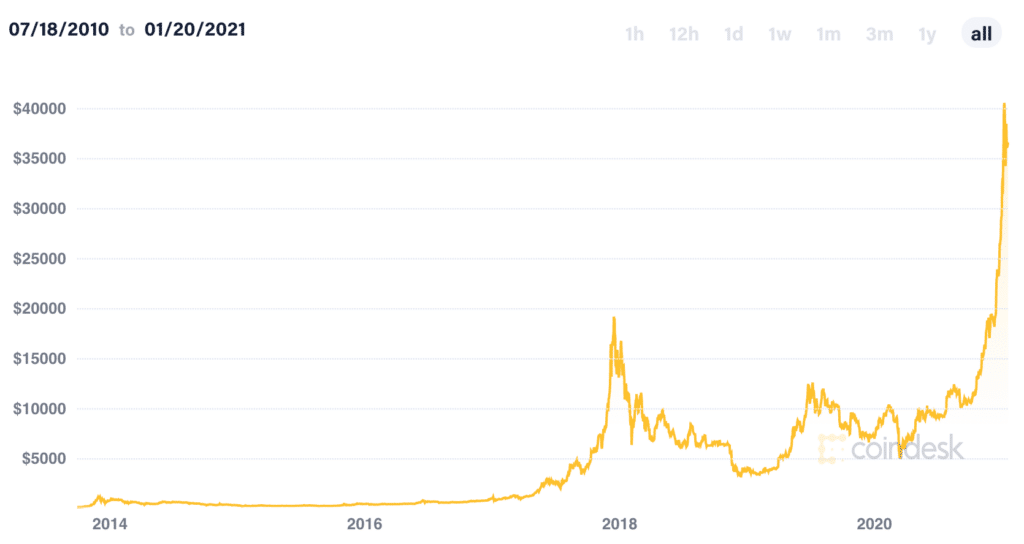
So why should this time be any different?
Here’s a bit of background on Bitcoin and Ethereum (the distant number two cryptocurrency):
Bitcoin really only has two uses: a digital currency and a store of value. The primary goal is to establish itself as an alternative monetary system. Like gold, there’s no intrinsic value but its price goes up or down based on public sentiment and speculation. Investors will bid the price up if they believe the demand for Bitcoin will increase, or sell and drive the price down if they believe demand will fall.
Ethereum, on the other hand, is an entire blockchain network that can be used to run decentralized applications, create and enforce smart contracts, and even create additional cryptocurrencies. Ether – the cryptocurrency of Ethereum – can be sent, received, and stored as digital money. It’s used to pay transaction fees on the Ethereum network.
You can buy Bitcoin and/or Ethereum on Wealthsimple Trade (WS Crypto), but the platform is quite a bit different than a traditional crypto trading platform like Coinbase where you actually hold crypto coins in digital wallets. WS Crypto simply allows you to trade the two cryptocurrencies – you don’t get to take hold of any coins in your own digital wallet. These traditional exchanges are prone to major hacks and security breaches. And, if you lose your “key” your coins are lost forever. Not ideal!
All of this said, I don’t recommend speculating on cryptocurrency any more than I’d recommend speculating on gold or other precious metals. Bitcoin is highly volatile, and if you do decide to buy make sure your stake doesn’t make up any more than 2-3% of your portfolio. You can’t hold it in an RRSP or TFSA, so it must be purchased in a taxable account and you track any capital gains or losses associated with buying and selling.
I don’t believe there is an ETF that holds a bunch of different cryptocurrencies. There is The Bitcoin Fund (QBTC) from 3iQ Corp – it comes with a management fee of 1.95%
Finally, I’ll leave you with one of my favourite investing charts from Carl Richards, called the Fear and Greed cycle:
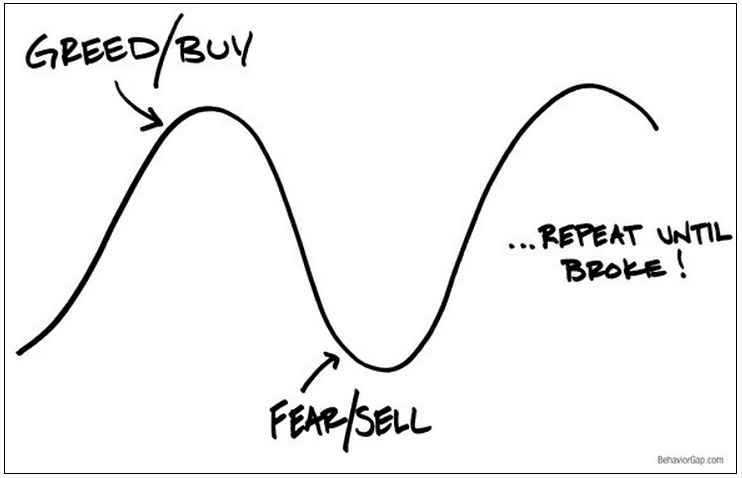
All the best!
Selling Stocks at a Loss
Here’s Norm, whose portfolio of individual stocks has taken a beating. He’s wondering when to pull the trigger on switching to a globally diversified index ETF. Sounds familiar:
Hey Robb,
I am planning to switch over my investments to a one-ticket ETF solution (VEQT) in a non-registered account, but I’m wondering about timing. Sadly, my portfolio is down significantly – the original investment of $175,000 is now down to $143,000. It’s largely made up of Canadian dividend payers that includes banks, materials, telecoms and oil stocks. It’s the oil companies that have ravaged the account – with some names down 80%.
I know it’s never a good thing to try to time the market, but I do feel like the banks, materials, and especially the energy sector finally have some tailwinds as the economy starts to reopen and could potentially recoup some of their losses. I wondered about waiting until this time next year, seeing how the portfolio does, and then making the official switch.
Hi Norm, thanks for your email. My advice would be to cut your losses and make the switch as soon as possible. You’ll benefit from the capital loss, which can be carried forward indefinitely to use against a capital gain in future years.
Related: Tax Loss Harvesting Explained
It’s a classic psychological mistake to wait for your losing stocks to come back to even. The stocks don’t care what price you paid for them. Their future prospects may continue to be bleak. Meanwhile, VEQT represents a significantly more diversified and therefore more reliable outcome over the long term.
You’ll still have exposure to all of those sectors, especially given VEQT’s 29% weighting to Canadian stocks.
It hurts to sell something at a big loss. I know, I’ve been there when I used to be a stock picker. It might be helpful to think of your non-registered portfolio as one large lump sum of cash right now. If it were in cash, would you re-purchase the exact same positions that you have now – or would you just buy VEQT? There’s your answer.
Selling Stocks at a Gain (to Rebalance)
Next up is Tracy, who took a chance on some growth stocks last year and now wonders if it’s time to take some profits and rebalance:
Hi Robb,
Last March I took advantage of the COVID dip by purchasing VEQT and some “play” stocks in electric vehicle companies. As a result of the growth in recent months, those “play” stocks now represent a double-digit percentage of my portfolio.
How does one go about rebalancing their portfolio in this scenario? Take out the original amount invested in the stocks (to buy VEQT) and leave the rest in? Leave it all in? Get out of the stocks altogether?
I don’t have much experience with stock investing, and I know you started in stocks, so thought I’d ask.
Hi Tracy, this would first depend on which account type you’re talking about. If in an RRSP or TFSA, I’d say trim your stock holdings by selling off shares to get you back to a comfortable level of “explore” compared to your core.
Yes, the idea would be to rebalance by using those proceeds to buy more VEQT. Set some rules around your stock picking, like no more than 5-10% of your total portfolio value, and then you’ll always have some guidance when to take some profits off the table.
Things are more complicated in a taxable (non-registered) account, as selling any holdings will trigger capital gains for this tax year (2021). You could get closer to your target asset mix by contributing any new money to VEQT only.
Letting your winning stocks ride can be risky as the range of outcomes is much more volatile with one single stock than it is with a globally diversified basket containing thousands of stocks.
Comparing Your Finances to Others
Finally, here’s a question from Peter who seems worried about how his finances are doing compared to his peers:
Hi Robb, I’m a relatively new passive investor, starting Jan 2019, but have been inspired by your timeline and I’m aiming for a goal you had early on: $100k by age 35.
I’m almost 34. My net worth is currently small at $76k. Therefore, my “plan”: save, save, save and at $100k seek out some fee-only advice (most likely yours) to hopefully find what I’m missing and if there are any inefficiencies in my portfolio.
What I didn’t realize until today though, upon reading your “2020 Year-End Review” post, was that at 35 you hit $100k in investments, PLUS you already had a home (purchased three years earlier). As a result, your net worth was MUCH higher than $100k at 35. Suddenly your timeline seems far less achievable…
My questions (finally):
-
- Should this dissuade me / am I on the right track?
- Does a home-purchase “before it’s too late” and then restarting my investment growth after that make any sense, especially considering I don’t really want or need a house currently?
- Does my “plan” make sense considering my late start to saving/investing?
Hi Peter, thanks for your email. I don’t think it’s useful to compare your situation to others. Everyone gets out of the starting gate at different times and with different circumstances that are largely out of their control.
Focus on your short- and long-term goals and strive to keep the needle moving forward each year. You can’t do everything all at once, so prioritize what’s important to you and make adjustments to those priorities as you move forward.
There’s nothing wrong with renting while you grow your investments. Renting offers flexibility and affordability, which can’t be understated.
If your employer offers a matching program, be sure to take full advantage of it. Make sure you’re investing the money in your TFSA rather than just keeping it in cash (if it is intended for long-term growth). Focus on increasing your savings rate each year. The milestones will come.
My finances were a mess in my 20s. I used my late 20s / early 30s to get them cleaned up and start saving. But I largely benefited from a sudden surge in real estate prices on my first home (from $129k to $239k in just a few years), which gave us some breathing room.
I changed careers to a slightly higher paying job that required less travel and was more of a 9-5. That freedom allowed me to start blogging, freelance writing, and eventually doing financial plans. The income earned from these side hustles significantly accelerated our savings goals.
My point is, don’t get bogged down looking at age-based savings goals. Focus on what you can control and keep improving each year. You’ll get there.
Best of luck!
Do you have a money-related question for me? Hit me up in the comments below or send me an email.

The Canadian housing market soared to new heights in 2020 as home prices and housing sales both hit record highs. The Canadian Real Estate Association reported a 47.2% year-over-year increase in annual sales activity, and a 13% year-over-year increase to the he MLS Home Price Index (HPI).
The average home price in Canada was a record $607,280 in December 2020.
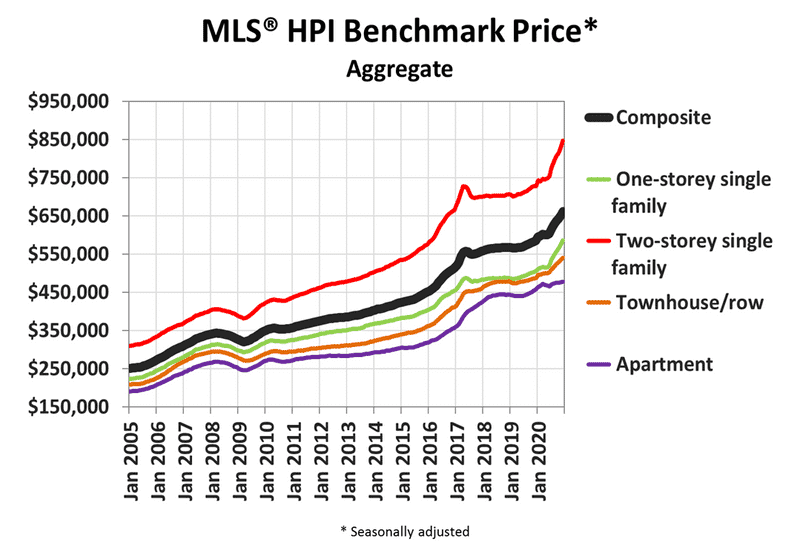
The housing boom, as usual, is led by sales in Vancouver and the GTA. Removing those two markets cuts nearly $130,000 from the national average.
But, as Global’s Erica Alini reported, the pandemic housing boom wasn’t just impacting Canada’s largest markets. Canadians flocked to the suburbs in search of more space.
The largest gains (more than 30%) were recorded in Quinte & District, Simcoe & District, Woodstock-Ingersoll and the Lakelands region of Ontario cottage country.
Rob Carrick and Roma Luciw tackled this trend in episode 3 of their excellent Stress Test podcast. Shelter-in-place restrictions have many people reconsidering their downtown condo living and moving to smaller communities. That makes sense in “these times” when many of us are working from home and don’t want to feel confined in a smaller home.
But what happens in the after times when life returns to a new version of normal? Companies may require their employees to return to the office, leading to longer, soul-crushing commute times for those who moved outside the city.
It will be interesting to see how this housing trend unfolds in 2021 and beyond. Meanwhile, rising prices continue to put pressure on housing affordability. What was once seen as mostly a Vancouver and Toronto problem is quickly becoming an issue in smaller centres as well.
This Week’s Recap:
I’ve updated my Wealthsimple Trade Review to include the addition of desktop access to the formerly ‘mobile-only’ trading platform.
I had the pleasure of chatting with Kornel Szrejber on the Build Wealth Canada podcast. We talked about optimizing your investments and finances for the new year and beyond.
From the archives – Eight habits that are killing your retirement dreams.
Promo of the Week:
The American Express Cobalt Card is one of the hidden gems in the Canadian rewards credit card landscape. It’s an annual winner of the top credit card in Canada for its 5x points earnings on eats and drinks, plus its robust redemption options.
This week Amex has increased the welcome bonus for the Cobalt Card to 45,000 points (up from 30,000 points). From our friends at Credit Card Genius:
The base welcome bonus offer is still around and remains unchanged. You’ll earn 2,500 bonus points every month you spend $500 in the first year, for up to 30,000 bonus points earned.
But now there’s a new addition to the welcome bonus. You’ll earn a lump sum of 15,000 bonus points when you spend $3,000 in the first 3 months. This part of the offer is only available until May 5, 2021 for new cardmembers.
Sign up for the American Express Cobalt Card today and take advantage of the generous 50% increase to its welcome bonus.
Weekend Reading:
One knock against Amex is that it’s not as widely accepted as MasterCard and Visa. Here’s how to use Amex credit cards at Costco and Loblaws with Instacart.
Congratulations to My Own Advisor’s Mark Seed for launching a new venture at Cashflows & Portfolios. Looks like it will be a great resource for Canadians.
Here’s a trifecta of articles written by (or featuring) Millionaire Teacher Andrew Hallam:
Why a schoolteacher who built a $1 million portfolio warns against investing in some mutual funds.
ETFs are healthier retirement options, so why don’t more advisers use them?
“If you’re wondering why most advisers don’t do this with their own money, Benjamin Felix, a financial planner with PWL Capital believes it may be because the Certified Financial Planner (CFP) education program is designed to ensure that professionals have a broad understanding of 12 topics core to the financial planning process. “Investments is one of those topics,” Mr. Felix says, “but there is no requirement to fully understand the evidence in favour of buying and holding low-cost index funds.”
It’s easy to be cynical, suggesting that advisers stuff actively managed funds into their clients’ accounts to boost trailer fees and commissions for themselves and their firms. But their personal holdings make something clear. In most cases, they simply don’t know what they don’t know.”
And, the two reasons why most rich people don’t buy expensive wine.
Here’s Stephanie Hughes with the tug-of-war between Canada’s small business community and rolling restrictions.
Fred Vettese was a guest on the Canadian Money Saver podcast talking about unconventionally planning for retirement.
A Wealth of Common Sense blogger Ben Carlson says it’s okay to build wealth slowly.
The Evidence-Based Investor explains the problem with stocks like Tesla:
“The most important takeaway is to avoid speculative stocks (like small biotech firms), which tend to be small, unprofitable, trade at high valuations, and experience high asset growth. On average, they disappoint. Broad, market-cap-weighted portfolios tend to have limited exposure to these stocks to begin with, particularly those that include large-cap stocks.
It may be tempting to set aside some “fun money” to try to catch the market’s next big winners early. However, the smaller those allocations are, the better.”
Rob Carrick compares GICs versus annuities to see which held up better as interest rates plunged.
Finally, John Heinzl answers a reader question about understanding income splitting rules before commuting your pension. He says that income from an LIF or RRIF does not qualify for splitting until the year in which the LIF/RRIF owner attains age 65. The pension credit of up to $2,000 can also be claimed in that year.
Have a great weekend, everyone!
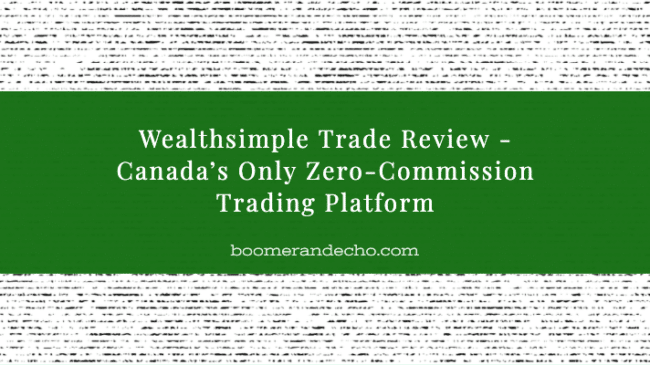
Wealthsimple Trade is Canada’s first and only zero-commission trading platform. In this Wealthsimple Trade review I’ll explain how you can buy AND sell from among the thousands of stocks and ETFs listed on North American exchanges without paying any fees.
I first heard about Wealthsimple Trade in 2018 when it was announced as a new self-directed investing platform that lets investors buy and sell stocks and ETFs with no trading commissions. They invited users to join a wait list and, once they attained a critical mass (130,000 participants), rolled out a beta version for users to test the platform and offer feedback.
Wealthsimple Trade officially launched in March 2019 and at that time only supported non-registered trading accounts. Later that year, the platform added RRSP and TFSA account types to its lineup. That’s when I became interested in the platform for my own self-directed investing needs.
Get a $10 cash bonus and commission-free trades when you open a Wealthsimple Trade account and deposit and trade at least $100 worth of stock.
Why I Switched to Wealthsimple Trade
I’ve held my investments at TD Direct Investing since 2009. It was out of convenience, more than anything, since I had banked with TD since I was a teenager. Back then trades disgustingly cost $29 per transaction. Today, they’re still a painful $9.99 per trade. I had enough when I noticed I paid a total of $190 in trading commissions with TD last year. No more.
I opened a Wealthsimple Trade account on January 13 2020, with the goal to bring my trading commissions down to zero. That same day, I initiated the transfer of my entire RRSP and TFSA account balances. Both of these accounts were invested in Vanguard’s all-equity balanced portfolio – VEQT – and so I requested an in-kind transfer which simply transferred the shares from TD to Wealthsimple Trade without first having to sell them.
An email from Wealthsimple suggested an expected wait time of up to five weeks to complete a transfer request with TD. But to my surprise I noticed the funds in my Wealthsimple Trade account on January 21 2020 – just seven business days later.
Now that you have the backstory, let’s take a look at the platform.
About Wealthsimple Trade
As mentioned, Wealthsimple Trade launched in March 2019 as Canada’s first and only zero-commission trading platform. It’s a separate, yet complementary service to Wealthsimple’s main business as Canada’s top robo advisor. With offices in Canada, the U.S., and the U.K., Wealthsimple manages more than $5 billion in assets worldwide.
Related: How to transfer your RRSP to Wealthsimple
Automated investing through a robo-advisor isn’t for everyone. Some investors want to take the reins themselves, build their own custom portfolio, and make trades in their own self-directed account. Enter Wealthsimple Trade.
While most online brokerages charge $9.99 per trade, Wealthsimple Trade doesn’t charge anything to buy and sell stocks or ETFs. It doesn’t charge account fees or have any account minimums to get started.
To get the costs down to the bare minimum (zero) the platform strips out all of the expensive bells and whistles. You won’t find cutting edge research or real-time quotes (there’s a 15-minute lag). Wealthsimple Trade also started out as a mobile app – on your smart-phone or tablet – with no desktop platform access. That, thankfully, has changed and Wealthsimple Trade now offers desktop access (January 2021):

But for self-directed investors who want to build a simple low-cost portfolio of index ETFs, and who want to contribute frequently without getting dinged each time they buy or sell, Wealthsimple Trade is the perfect platform.
Signing Up and Opening an Account
How do you open an account? Easy. Download the Wealthsimple Trade app on your Apple or Android device and select ‘Get Started’. From there, follow the prompts to enter your information and agree to your account documents.
Note that even though the Wealthsimple Trade app is NOT connected at all to the Wealthsimple robo advisor platform – existing Wealthsimple clients can skip some of the preliminary questions.
Here’s what you’ll need to get started:
- Full Name, Email, Mailing Address, Phone number, Date of Birth
- Social Insurance Number
- Employment information
There are no account minimums or fees associated with opening the account. To fund it, though, you’ll need to link a chequing or savings account.
Transferring Investments to Wealthsimple Trade
Transferring my existing investments to Wealthsimple Trade couldn’t have been easier. As mentioned, I initiated the transfer on January 13, 2020. I entered a few details about the accounts I was transferring, selected the institution (TD) from a list of choices, and snapped a picture of my account statements.
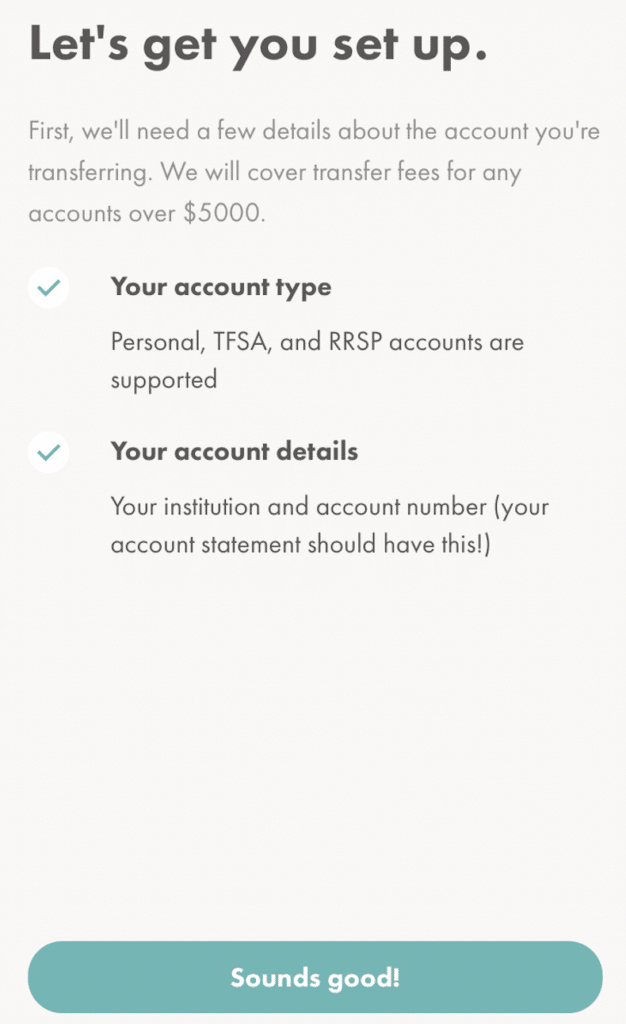

Next, I indicated how I wanted the transfer to take place. Typically, you can choose to transfer funds in cash, meaning your institution sells your current holdings and then moves the money. If you go this route, you may incur DSC or trading fees. Note that your contribution room or taxes won’t be affected when you transfer a non-taxable account like an RRSP or TFSA.
Instead, I chose to transfer my account in-kind or “as-is”. This means your institution transfers your entire account. Note that Wealthsimple Trade only accepts the transfer of stocks and ETFs. You’ll have the option to sell non-eligible assets like mutual funds, bonds, or options, or leave them with your institution.
As I said earlier, the entire transfer process took just seven business days. Your mileage may vary.
Using Wealthsimple Trade
Wealthsimple Trade works like any other online brokerage, with the exception that it’s a mobile-only platform. There’s no desktop support.
To search for a stock or ETF, tap the search icon at the top-right of your screen and enter the name or ticker symbol.
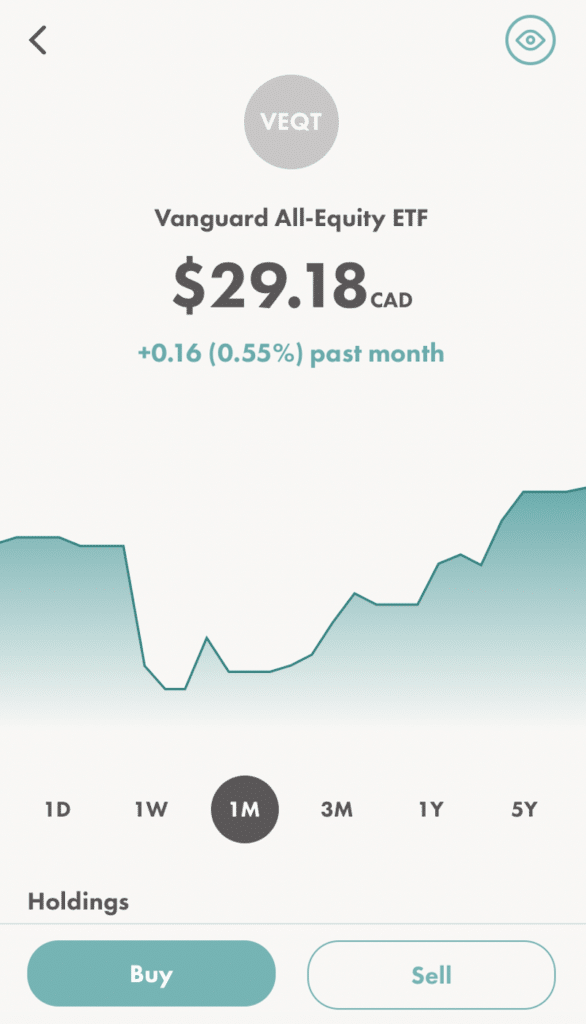
Once you have the stock or ETF profile up on your screen, simply tap the ‘Buy’ or ‘Sell’ button. Then, select the account in which you want to buy the stock or ETF (RRSP, TFSA, or non-registered).
Now, enter the number of shares you wish to purchase. You’ll see the current price of that security, the estimated cost, and how much you have available to trade. Remember that Wealthsimple Trade does not show real-time quotes – there’s a 15-minute delay in the market information.
This is a good time to remind you about bid-ask spreads and market vs. limit orders.
The bid price is the what you’re likely to get if you’re selling the stock or ETF. The ask price is the price you are likely to get if you’re buying the stock or ETF.
The default purchase setting is for a market order. This means your order will be filled at the best available price on the market.
With a limit order, you choose the highest price you are willing to pay (your limit). Your order will only complete if and when the market price is at or below your limit.

Wealthsimple Trade Highlights
What stands out the most for me about Wealthsimple Trade is of course the ability to buy and sell ETFs for free. I was paying $9.99 per trade for years – which is what most discount brokerages charge. Yes, a select few brokers offer free ETF purchases, but Wealthsimple Trade is the only platform that offers zero-commission trades across the board (buy or sell).
You can choose from thousands of available stocks and ETFs that traded on North American stock exchanges (NYSE, NASDAQ, TSX, TSX-V). You cannot trade mutual funds, options, preferred shares, over-the-counter securities (OTC), or stocks that trade outside of North America.
Wealthsimple Trade will reimburse any transfer fees on transfers larger than $5,000.
The mobile app is incredibly intuitive and user friendly. And, the new desktop access is an excellent addition to the Wealthsimple Trade experience.
The app is secure and fully encrypted, relying on two-factor authentication protection to keep your data safe. It requires a PIN, and you can also enable touch ID to access your account.
Your money is secure. Wealthsimple Trade is a division of Canadian ShareOwner Investments Inc. and is a member of the Canadian Investor’s Protection Fund (CIPF) which protects accounts up to $1,000,000 against insolvency.
The zero-commission trade platform is ideal for investors who have simple, low cost portfolios and who frequently add new money to their accounts.
Downside to Wealthsimple Trade
I’d be remiss not to mention any cons to the Wealthsimple Trade platform.
For one, clients are limited to three account types at this time (RRSP, TFSA, and non-registered accounts).
The platform is mobile-only, so it can only be accessed on your smart-phone or tablet. A desktop version has been rolled out as of January 2021.
There is no option (at this time) to support auto-deposits. Instead, a one-time deposit must be set up each time you’d like to fund your account.
While not necessarily a con, you should know that Wealthsimple Trade makes its money by charging a 1.5 percent currency conversion fee on CAD to US dollar conversions (and vice versa) that are required to trade US-listed stocks and ETFs.
Finally, since this is a no-frills platform, you won’t find in-depth research on stocks and ETFs. Also, stock quotes are not updated in real-time – there’s a 15-minute delay.
Wealthsimple Trade Review: Pros and Cons
| Account fees | None |
| Trading fees | None |
| Account minimum | $0 |
| Other fees | Corporate rate + 1.50% for CAD to USD foreign exchange |
| Minimum deposit | None |
| Account types | RRSP, TFSA, non-registered account |
| Access | Mobile app and desktop |
| Transfer fees | Wealthsimple Trade will reimburse transfer fees on transfers greater than $5,000. |
| Market research | Wealthsimple Trade does not have in-depth market research and does not support real-time quotes (delayed by 15 minutes) |
Wealthsimple Trade vs. Questrade
I considered moving my self-directed investing accounts from TD Direct to Questrade before ultimately switching to Wealthsimple Trade.
Questrade has long been known as the top discount brokerage in Canada due to its low fee structure, free ETF purchases, and stock trading for as low as $4.95. Questrade has also been around the block for 20+ years and built a solid reputation for its robust platform, market research, and customer service.
If you’re the type of investor who has more advanced trading needs, or someone who needs to hold more than just an RRSP, TFSA, or non-registered account (like a LIRA, RESP, Joint investing account, or Corporate account), then the Questrade platform is still an excellent choice.
I like the no-frills approach to Wealthsimple Trade, and I like that, as a company, Wealthsimple is committed to continuously improving their product lines. As an example, they just announced a new hybrid chequing and savings account product called Wealthsimple Cash that pays slightly better interest than the big banks.
I figured, since I will be trading frequently (by my standards) – at least once per month in my TFSA, plus a few times a year in my RRSP – and I don’t need access to more account types at this time – Wealthsimple Trade would suit my needs just fine.
Final Thoughts
I’m happy with my decision to move my RRSP and TFSA accounts to Wealthsimple Trade and finally avoid paying $9.99 per trade when I contribute money to my investments.
This platform is ideal for any investor who is comfortable in a mobile app or desktop environment and who wants to trade stocks and ETFs without paying any fees.
Wealthsimple Trade is especially suited for investors who make frequent contributions to their investment accounts, since they can buy small amounts without worrying about getting charged a commission every time. This puts more of your money to work right away, rather than saving up an appropriate amount of cash before buying (which is what I would do at TD Direct).
Open a Wealthsimple Trade account and enjoy commission-free trading.
Watch for more improvements to roll out over time, as Wealthsimple Trade hopefully adds more account types and the ability to auto-deposit from your bank account (perhaps a direct link with its new Wealthsimple Cash account?).
